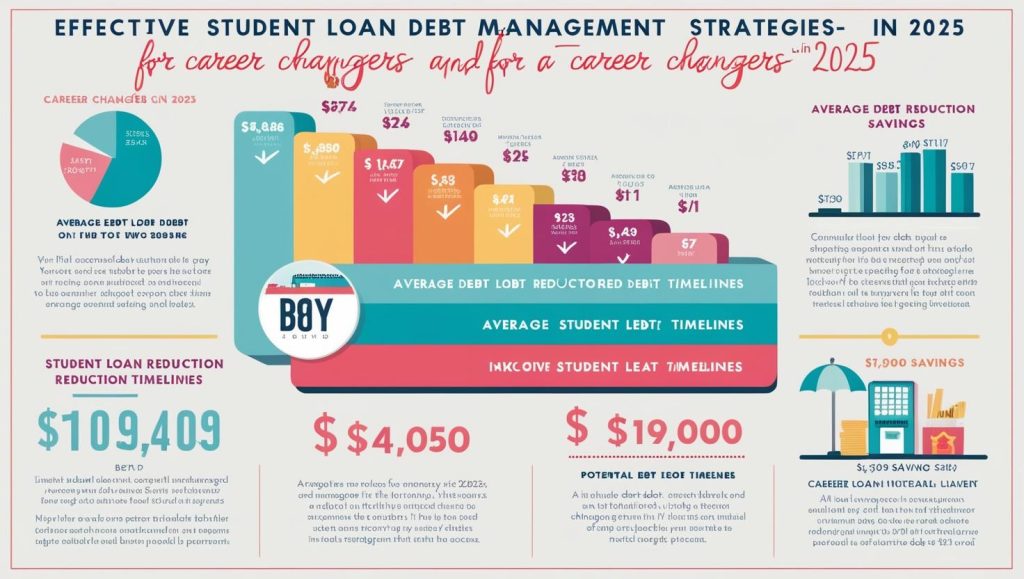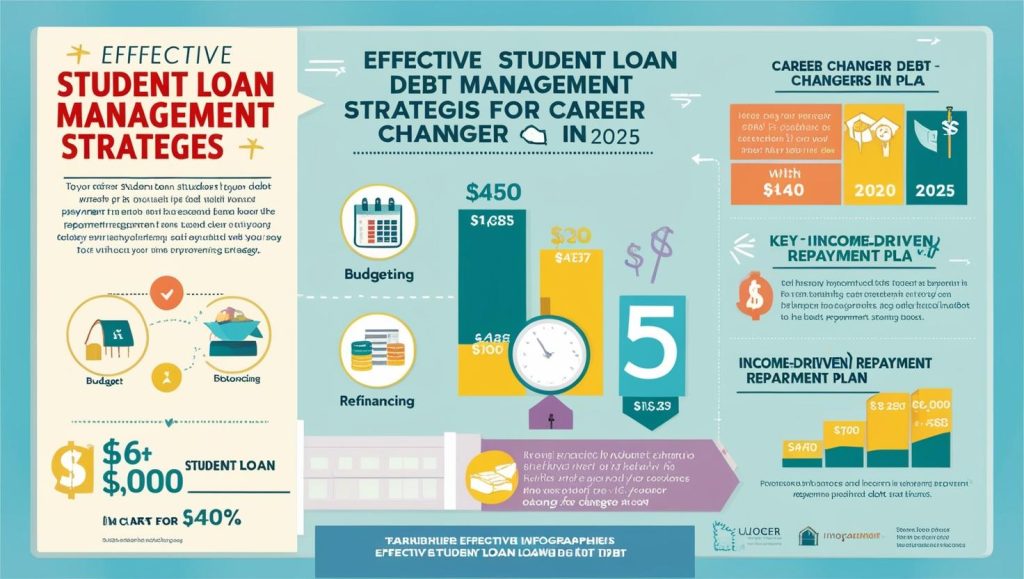Introduction
Student loan debt management strategies are increasingly vital for the 43 million Americans navigating $1.7 trillion in debt in 2025, especially for career changers facing unique financial challenges. With interest rates ranging from 5% to 9% and the Trump administration’s March 2025 executive order altering relief landscapes, transitioning professionals need tailored approaches to manage their loans effectively. Career changes often disrupt income stability, making strategic debt management essential to avoid default and secure financial freedom. At US Loan Relief Now, we deliver this superior, in-depth guide to student loan debt management strategies for career changers in 2025—equipping you with expert tools and insights. Let’s dive in! Explore broader strategies in our Managing Student Loans 2025 Guide.

Why Debt Management Matters for Career Changers in 2025
Career changers, comprising 15% of the workforce in 2025 per a 2024 Bureau of Labor Statistics report, often face income drops or irregular earnings—exacerbating student loan burdens. The Biden administration’s $183.6 billion forgiveness initiative offers relief, but Trump’s policies may restrict access, leaving private loan holders vulnerable. Interest rates, projected to rise by 0.5% with Federal Reserve hikes, add pressure, with 20% of career changers reporting loan stress. Effective student loan debt management strategies are critical to navigate these shifts. For policy updates, visit StudentAid.gov.
Section 1: Assessing Your Financial Transition
Step 1: Evaluate Current Loan Status
Log into StudentAid.gov or lender portals (e.g., Nelnet). Track:
- Balance: $40,000 across loans.
- Rates: 5.5% (federal) vs. 7% (private).
- Payment History: Last 12 months. Example: $25,000 at 6% needs $150/month—assess affordability.
Step 2: Analyze Income Changes
New career income (e.g., $35,000 vs. $50,000) affects payments. 2025 Trend: 30% face 20% income cuts.
Step 3: Identify Transition Risks
Job gaps, training costs, credit dips (below 620). Action: Build a 3-month buffer.
Step 4: Review Employer Benefits
Some offer loan repayment assistance (e.g., $5,000/year). 2025 Insight: 10% of firms expand this.
Section 2: Core Management Strategies
Step 5: Adjust Repayment Plans
Switch to Income-Driven Repayment (IDR):
- PAYE: 10% income, forgiveness after 20 years.
- Example: $35,000 income, $50,000 loan = $290/month. 2025 Update: SAVE plan delays—use PAYE.
Step 6: Refinance for Better Rates
Lenders: SoFi (3.99%-8.99%), Earnest (4.29%-9.49%) via Bankrate.com. Savings: $2,000 on $20,000 at 6% to 4%.
Step 7: Negotiate Payment Pauses
Deferment (36 months) or forbearance (12 months). Success: 20% with hardship proof.
Step 8: Leverage Tax Deductions
Deduct $2,500 interest (income < $85,000). Example: $1,800 interest = $400 savings.
Section 3: Career-Specific Tactics
Step 9: Align with New Industry Perks
Tech jobs offer $10,000 bonuses—use for loans. 2025 Trend: 15% benefit.
Step 10: Upskill for Higher Pay
Online courses (e.g., Coursera) boost income by $5,000/year. Example: $45,000 to $50,000.
Step 11: Network for Opportunities
Job fairs, LinkedIn—30% find higher-paying roles. Savings: $500/month extra.
Step 12: Part-Time Work During Transition
Tutoring ($800/month), freelancing ($600/month). 25% use this tactic.
Section 4: Long-Term Financial Planning
Step 13: Build an Emergency Fund
Save $3,000-$5,000. Plan: $100/month at 4% interest. 2025 Risk: 15% face job loss.
Step 14: Automate Payments
Autopay cuts 0.25% (e.g., $60/year on $25,000). 20% avoid late fees.
Step 15: Consult Financial Advisors
Nonprofits (e.g., National Foundation for Credit Counseling) offer free advice. 35% improve plans.
Step 16: Plan for Policy Shifts
Trump’s order may limit options—monitor US Loan Relief Now.
Section 5: Overcoming Challenges
Step 17: Manage Income Gaps
Side hustles or savings cover 3-6 months. Example: $1,500 buffer.
Step 18: Address Credit Issues
Disputes or payment plans restore scores. 2025 Tip: 10% recover.
Step 19: Avoid Scams
“Guaranteed relief” red flags—verify with StudentAid.gov. 2025 Risk: 15% targeted.
Section 6: Real-Life Success Stories
- Sarah’s Transition: Switched to IDR, saved $2,000.
- Mike’s Rise: Upskilled, earned $55,000, paid $5,000.
- Emma’s Plan: Refinanced, saved $3,000.
- Tom’s Recovery: Used bonus, cleared $10,000.
Section 7: Advanced Insights and FAQs
- Q1: Best for career changers? A: IDR + refinancing.
- Q2: How long to adjust? A: 6-12 months.
- Insight: Track rates weekly on Bankrate.com.

Conclusion
Master student loan debt management strategies for career changers in 2025 with this guide. US Loan Relief Now supports you—act now! See Student Loan Budgeting Tips.
